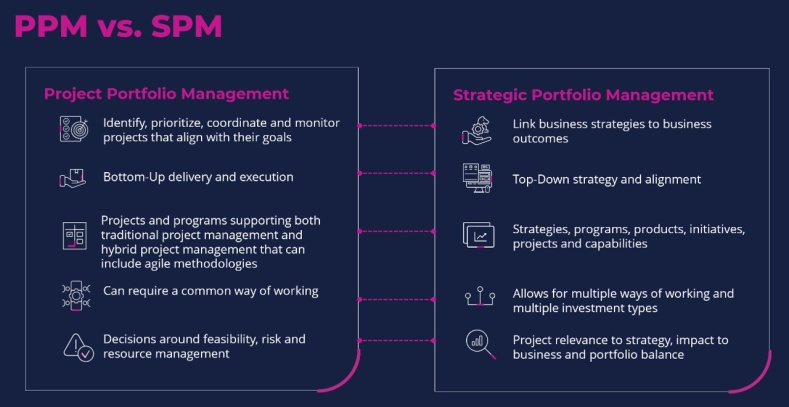Updated: October 2025
Facing tight budgets and fast-shifting business priorities, many project management offices (PMOs) are fighting to achieve excellence and prove their strategic value.
Key to this: investing in the right change and keeping up with the latest technologies, frameworks, and methodologies.
For PMOs, this pursuit has increasingly meant adopting strategic portfolio management (SPM) practices, building on the success of project portfolio management (PPM).
But how do these two methodologies, PPM and SPM, differ? How do they relate to each other? Ultimately, which is right for your business?
What is project portfolio management (PPM)?
For over 20 years, project portfolio management has enabled organizations to more efficiently centralize and manage their program and project portfolios.
Considered a tactical “bottom-up” approach with an operational focus, PPM gives PMOs visibility at the project portfolio level and helps them to align initiatives with broader organizational goals.
PPM provides oversight of all projects, offering an objective, measurable way to prioritize, execute, and track projects so that they deliver the greatest possible value. PPM empowers PMOs to make informed decisions about whether a project is on track and delivering true value for the organization.
After all, the goal of PPM is not to help PMOs find a way to do all possible projects, but rather to shift focus from “doing a project right” to “doing the right projects.”
To achieve this, PPM allows PMOs to:
- dedicate resources to projects that maximize short- and long-term value
- identify, rank, coordinate, and track projects that align with organizational goals
- empower all team members to make decisions and drive bottom-up delivery and execution
- opt for both traditional and hybrid project management approaches, including Agile methodologies
- gain insight into project feasibility, risk, and resource management.
With these benefits in mind, it’s clear why, as digitalization accelerates, PPM platforms have become essential tools, helping PMOs to make more data-driven decisions.
What is strategic portfolio management (SPM)?
Strategic portfolio management, on the other hand, embraces a top-down approach to projects and portfolios, emphasizing continuous alignment and adaptability from business-wide strategy to execution.
It’s about evaluating the strategic relevance of programs, projects, and initiatives and uniting them into a cohesive approach that articulates and achieves an enterprise-wide vision. In other words, SPM brings project portfolios closer to your organization’s long-term strategic goals.
With SPM, every decision is justified by its contribution to a strategic outcome. As such, it promotes continual appraisal of all projects, programs, and portfolios in terms of strategic value.
By providing visibility across all initiatives and highlighting the importance of ongoing planning and adaptability throughout the entire portfolio management process, SPM closes the gap between business strategy and Agile methodologies.
Since its introduction in 2017 by Forrester Research, SPM has transformed the project management market by promoting:
- flexibility for teams to adapt to changing requirements and scope
- speed through incremental changes, short iterations, and frequent feedback
- enhanced collaboration and communication between stakeholders and team members.
This has encouraged organizations to redefine how they deliver products and services, both at the project- and company-level (also known as scaled Agile). SPM can benefit PMOs by providing:
- strategic alignment: clear links between high-level business strategies and tangible outcomes
- long-term focus: identification of project relevance to the broader strategy, including initiatives several years into the future
- holistic visibility: insight into the project portfolio’s overall impact on the business, balance of investments, and risk exposure
- agility and adaptability: the ability to pivot in response to market changes, emerging technologies, or shifting customer needs
Differences and relationships between PPM and SPM
PPM and SPM both build on the fundamental methodology of project management. Their distinctions become clear when we define them alongside each other.
- Project management focuses on project delivery, offering visibility at the project level alone.
- PPM takes project management one step further, providing a framework for selecting the right value-driving initiatives, monitoring their execution, and delivering visibility at the portfolio level.
- SPM is about clearly articulating strategy and outcomes and translating them into projects, products, or services that deliver a unified vision. It provides visibility at an organizational level.
In mature organizations, SPM is not a complete and direct replacement for PPM, but rather a complementary approach to portfolio management: SPM augments PPM, elevating project choices to a more strategic level.
PPM is driving the car—managing speed, fuel, and navigation—while SPM is choosing the destination and route, making sure the trip has purpose and meaning. Essentially, PPM asks “how?,” while SPM asks “why?”
Both PPM and SPM have their place in a project-centric framework. For example, a bank might use PPM to evaluate the feasibility of (and deliver) a new mobile app. SPM guides the choice of this initiative, ensuring it’s not just another IT project, but part of a larger digital transformation strategy for modernizing services in the fast-paced financial services market.

For businesses that experience shortened planning cycles and have embraced digital transformation, PPM alone is generally considered too departmental and “bottom-up”. SPM’s top-down, organization-wide, longer-term approach is suited to these fast-paced, digital-first environments.
Embracing SPM: the role of tools and OKRs
The modern-day key to driving more strategic thinking and alignment? Finding a tool which facilitates PPM and SPM. These solutions can manage all projects, programs, and portfolios in one place and provide real-time insights to ensure that all new initiatives are tied to company-wide vision and strategy.
Objectives and Key Results (OKRs) are one key feature to support SPM adoption. A goal-oriented framework and a key tenet of SPM, OKRs help you to visualize and connect strategy to execution. They’re key for PMOs wanting to demonstrate their contribution towards company goals.
Our ultimate guide to OKRs for strategic portfolio management explores why OKRs and SPM are a great match, the best OKRs to track, and how to set them. We’ve also discussed considerations for implementing OKRs in your organization and the five best OKRs when it comes to measuring the impact of your SPM initiatives.
Unlock greater visibility and strategic value with Planisware
Planisware’s tools support strategic decision-making at the project, program, and portfolio level.
Whatever maturity stage you’re at, we can help you to drive forward your approach. That may mean moving from project management to PPM, or building on PPM to include SPM.
Our solutions have a range of innovative features and AI-powered capabilities that empower PMOs to identify opportunities and choose those needle-moving investments.
We are recognised as leaders in SPM (by Forrester in The Forrester Wave™) and Adaptive Project Management and Reporting (in Gartner®’s Magic Quadrant™ and Critical Capabilities reports).
To learn how Planisware can help you realize your vision, elevate project success, and transform the strategic value of your PMO, book a one-to-one demo today.


